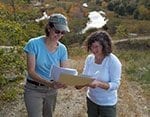
On Friday October 14, 2016, wetland ecologists and climate resiliency planners from BSC attended the Society of Ecological Restoration – New England, two-day conference titled Ecological Restoration in a Changing Climate. Our very own Mike Toohill (SER-NE Board Member and Treasurer) and the rest of the SER-NE Board organized an excellent day of presentations. BSC’s Gillian Davies presented an afternoon session on her work at Crosby Corner: “Using and Interpreting IRIS Tubes to Assess Wetland Mitigation Success in Created Wetlands.”
The highlight of the day was the incredibly interesting restoration project at Tidemarsh Farms in Plymouth, MA. Tidemarsh Farms is home to the largest (250 acre) freshwater wetland restoration project in New England. Participants were introduced to new and innovative approaches to measuring complex ecological systems and methods to convey scientific information to the general public. A diverse set of stakeholders organized for this project has facilitated the restoration of a former cranberry bog to a diverse ecosystem that functions as a Research Facility, Living Observatory, Plant Nursery (the plants for the restoration effort were grown on-site), and Dynamic Virtual Website (partnership with the MIT media lab).
The Monday following the conference, another important partnership was formed. The Society of Wetland Scientists (SWS) and the Society of Ecological Restoration (SER), in keeping with the mission of the two Societies, visited Tidemarsh Farm to sign a Memorandum of Cooperation. The Massachusetts Division of Ecological Restoration Director Tim Purinton and restoration site owners Glorianna Davenport and Evan Schulman generously hosted SWS and SER for this amazing visit and important agreement.
With over 14,000 acres of cranberry bogs set for retirement in Massachusetts – as large scale cranberry cultivation transitions to more cost effective upland habitats – there is a need to learn as much as possible about the ecological outcomes of restoration efforts within these highly disturbed ecosystems.
The Living Observatory is a particularly cool approach that is being used at Tidemarsh Farms to research the processes by which wetlands respond to restoration actions (for example do they sequester or emit carbon). Tidemarsh Farm is currently the site of a diverse set of research initiatives, whereby data collection is integrated into a Dynamic Virtual Website. Visitors to the virtual website can interact and experience the wetland in the field or over the internet. For example, audio sensors have been placed throughout the farm, whereby someone wearing a specially designed headset can listen to wildlife that they can see from across the marsh, but are beyond earshot. Another example is of fish that have been tagged in the field, can be followed throughout the wetland system while navigating the restoration site in a virtual environment. There is also a plan to place an audio device on wood debris, so people can listen to the decomposition process as insects eat the logs.
In a changing climate, it is evident that new approaches are required to obtain successful outcomes in wetland restoration projects. In addition to the core principles of wetland ecology, restoration projects require creative and interdisciplinary partnerships to successfully navigate complex human influenced wetland ecosystems. As we are seeing at Tidemarsh Farms, there is also a place for technology and big data to pair with these efforts and facilitate the process. How ecology, partnerships, and big data combine to drive these efforts forward remain unclear, but these approaches present an opportunity to broaden and diversify the number of people who are engaged in wetland ecology.
